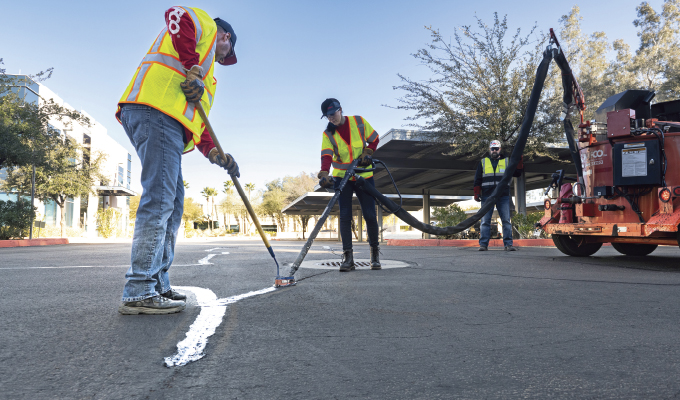In the 1990s, the Federal Highway Administration conducted an ambitious test spanning several years at five locations across the US and Canada. The goal was to finally resolve a longstanding question: is there any real difference between crack filling and crack sealing? Those terms may sound the same, but the difference determines how long our roads and other pavements will last.
To understand the issue, let’s go back in time to the late 1960s. At that time, pavement preservation essentially didn’t exist. Road building materials like asphalt were cheap, and public agencies generally had full coffers, so when a road began to deteriorate, it was simply replaced. Once the oil embargoes of the 1970s struck, however, the math quickly changed. The oil-derived asphalt needed for building most roads became vastly more expensive, and agencies began looking for ways to extend the life of their roads.
ROAD DETERIORATION
One of the first ways a road usually begins to deteriorate is cracking caused by vehicle loads, thermal movement, and other factors. Researchers working on behalf of public agencies noticed that cracking often led to potholes and eventual disintegration of the asphalt surface. That’s because water and uncompressible debris get into cracks and further break up the asphalt through mechanisms like the freeze-thaw cycle and the expansion-contraction of the asphalt itself.
It soon became common to fill the cracks with hot liquid asphalt—the precursor to today’s polymer-modified, hot-applied crack sealants. That early practice of “crack filling” was refined through trial and error into “crack sealing,” a more thorough process that involves routing, cleaning and drying cracks, then applying sealant into and over the crack. While crack filling means reducing the infiltration of water and debris, crack sealing means preventing that infiltration altogether. For agencies and contractors who sought to make the most of their budgets, the temptation to simply fill cracks seemed alluring, especially without data showing that crack sealing significantly extended service life.
FHWA EXPERIMENT
Enter the Federal Highway Administration. Their experiment in the ‘90s sought to definitively test the most cost-effective solution for treating cracks. FHWA selected test sites in Texas, Washington, Kansas, Iowa and a partner site in Ontario, Canada, representing climates with wet freezing winters, wet non-freezing winters, dry freezing winters, and dry non-freezing winters.
At each site, FHWA selected existing roads that had started to display cracking but were otherwise in good condition. The test sites were divided into several sections which received varying levels of surface preparation like routing, compressed air or wire brushing, along with different configurations of crack filling or crack sealing. FHWA also evaluated several different brands of crack sealant, including some of Crafco’s products.
WINNER EMERGED
After the treatments were applied, FHWA continued to monitor the conditions of each segment, noting the type and level of deterioration. By the time the experiment was over, a clear winner had emerged: crack sealing outperformed crack filling by a significant margin. The most effective method by far in every case was routing the crack, blasting out dust and debris with compressed air, and sealing the crack with an overband or “band-aid.” The results were clear: when the right sealant is applied to a correctly prepared surface in a reservoir-with-overband configuration, the pavement will significantly outlast “blow-and-go” treatments. That little bit of extra effort translated into several years of expected additional lifespan for the sealant, which ultimately means a longer service life for the road.
The FHWA study found that sealant applied as a simple band-aid over non-routed cracks will last an estimated 44.5 months (3.7 years). Routing the same crack and filling it flush to the pavement will extend the sealant life up to an estimated 70 months (5.8 years). The addition of a band-aid over top of a reservoir boosts the expected sealant life even further, to 92.9 months (7.7 years) for a shallow reservoir and 94.5 months (almost 7.9 years) for a standard reservoir.
Why does a reservoir make so much difference? In the hot summer months, pavement expands and causes cracks to narrow, squeezing the sealant up above the surface, where it is worn away by the tires of passing vehicles. Once cold weather returns and the crack widens from pavement contraction, the crack will be left with less sealant, stretching the sealant beyond its elastic limit and causing it to break.
The solution to that problem is providing a reservoir of extra sealant to compensate for that natural cycle of expansion and contraction. Once the topmost layer of sealant is worn away by traffic during the summer, there is still plenty of sealant remaining in the reservoir to withstand stretching in the winter. Routing also removes loose material from the face of the crack, preventing the sealant from pulling the loose material free and compromising the seal.
Since that FHWA study in the ‘90s, there have been numerous additional tests by objective third-party researchers, all confirming the value of proper crack sealing for pavement preservation. A pavement surface with routed and sealed cracks will remain in good condition long after a neglected pavement will need complete replacement. In fact, crack sealing has been shown to improve the effectiveness of other pavement preservation techniques like chip sealing. And though crack sealing correctly requires slightly more effort, the payoff is many more years of sealant service life and a long-term reduction in labor and cost. Dollar-for-dollar, proper crack sealing is the most cost-effective method of pavement preservation with the least interruption to traffic.
CLOSING THOUGHT
Doing the job right is an investment in the future of our infrastructure, and it’s a boon to your reputation when your work stands the test of time.
For More Information:
Visit crafco.com for more information. Find the original FHWA study report at www.fhwa.dot.gov/publications/research/infrastructure/pavements/ltpp/99143/99143.pdf.
Modern Contractor Solutions, November 2023
Did you enjoy this article?
Subscribe to the FREE Digital Edition of Modern Contractor Solutions magazine.



